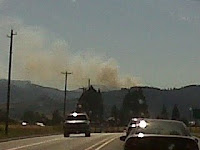According to charts provided by the Oregon Department of Forestry, wildfires are more prevalent throughout July, August, September, and even October. We may think that the danger ends in September, but depending on the weather, it can continue well into the fall. Until significant rainfall occurs, the ODF says that major restrictions will remain in place well into the fall.

This brush fire burned approximately an acre and was believed to have been started by a hunter on SW Fernhill Road last year
There are many restrictions currently in place on all Tillamook state forests and surrounding properties due to the current fire danger. Forest fires are too often caused by unattended campfires and smokers who fail to extinguish their cigarettes. To prevent this, the ODF has placed a ban on both. Absolutely no campfires are allowed on public or private land except in designated areas such as campgrounds. Smoking is prohibited unless kept inside closed vehicles on improved or well-maintained roads. ATV's and motorcycles are not permitted unless on improved roads because of the dry conditions and no non-industry use of chainsaws is allowed in any case.
The heavy restrictions may disappoint many hunters who plan on camping, but it is imperative to pack according to the current regulations. One very important thing to know when creating a packing list is this: when traveling on any unpaved county or logging roads all hunters must carry a fire extinguisher or one gallon of water and one shovel in their vehicles. It's not just a recommendation this year, it is required.
The regulations and fire dangers are different for every unit and area so it is very important to know and understand the regulations for the unit you will be hunting in. You can find information about the fire dangers in your unit by contacting the Oregon Department of Forestry, or by visiting their website at
FGF&R wishes for everyone to have a fun, successful, and safe hunt this year. Pack according to the current fire danger and remember to stay updated on the restrictions taking place in your unit. Enjoy your hunting season, and good luck!


